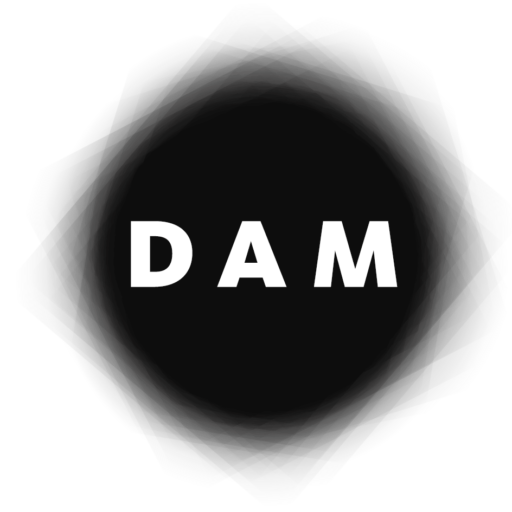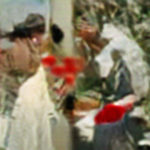
Casey Reas is one the leading artists creating software-based, generative artworks nowadays. Active since 2000, he has exhibited worlwide in contemporary art museums, galleries, festivals, and other venues. He is the co-creator, with Ben Fry, of the programming language Processing (2001) and has authored many books on creative coding.
Website of Casey Reas:
www.reas.com
Compressed Cinema (2018-present)
The series Compressed Cinema comprises five audiovisual works with video images created by Reas and an audio track composed by Jan St. Werner. The images for the videos were derived from a set of “film stills” created by Reas with generative adversarial networks (GANs). This process is documented in REAS’ 2020 book Making Pictures with Generative Adversarial Networks.
Atomism (2012-present)
This series consists of different versions and applications of software in the generation of abstract forms, with the final output being both software-based generative artworks, and prints. Among others, it includes the mural A Mathematical Theory of Communication (2014), commissioned by Landmarks, the public art program of the University of Texas at Austin.
Ultraconcentrated (2012-present)
Comprising software-based generative artworks and prints, this series is characterized by the introduction of broadcast images, which are algorithmically altered to become almost abstract forms, yet retain some of their original meaning.
Process Compendium (2004-2014)
One of the most important series in Reas’ work, Process encapsulates the artist’s exploration of the phenomenon of emergence using a system that allowed him to endlessly generate visual compositions based on a combination of Forms, Behaviors, Elements, and Processes. This series is documented in the book Process Compendium, 2004-2010 (REAS Studio, 2010).
MicroImage (2001-2004)
The earliest series in the work of Casey Reas comprises software-based generative artworks, prints, and garnments. The pieces we created using the custom-made Tissue and Path software programs, which draw inspiration from the ideas of neuroanatomist Valentino Braitenberg.

The Work
Casey Reas
Text posted on the artist’s GitHub profile, 2016
The Work is continuous changing; at each moment it’s different than it was before. This is in contrast to a drawing or painting that is largely fixed in time. It’s in contrast to a work in film or video that is in constant motion, but has a fixed beginning, end, or loop. Of course these works change with the light in the room, as the materials degrade, and through our experience of viewing them, etc. but that’s a different kind of change. This Work is most like a performance that is free to follow variable and unexpected paths. The Work is visual media and it’s time-based media, but it’s also conditional media. What is conditional media? It’s an open work, as defined by Eco in Opera aperta.
In digging deeper into the nature of the Work, it appears to be software, or maybe the source code for the software, but it’s not. The Work is more fundamental — it’s a set of instructions that defines a System. These instructions exist only to realize visual or audiovisual information, but from the point of view of creating the Work and of conservation, the most important aspect of the Work is the information encoded in the instructions.
The System is sometimes defined in English, but it’s most often defined in source code. There’s nothing authentic or precious about the specific source code notation of the Work; the instructions can be clearly defined in a number of notations. The notation is essential to the work because it clearly codifies it, but the notation is not the work. The software application or executable that is a compiled version of the notation is also essential for experiencing the Work, but it’s also not the Work.
Because it’s a set of instructions, the Work is essentially immaterial, but it’s always realized as light and/or sound. In fact, the instructions exist only to choreograph images and sounds in time and space. This is similar to how a composer works. A score for music uses notation to define a sequence of sounds in the way instructions for the Work in source code define a visual system. A score is immaterial like code, but the primary goal of the score is to define a sensory experience. Similarly, a script for a theater performance is a notation system that integrates dialog and stage directions, but it exists primarily to be performed. With all, there’s a separation of the notation as one form of the work and the performance of the notation as the manifestation.
The software application or executable that encodes the system is the most fragile form of the work related to conservation, but it’s the most useful day to day. It’s the element that can be installed and run on a computer so people can experience the work. Unlike more traditional media, there is no original version of this software. It’s a digital file that can be copied without degradation and each copy is identical. Over time, a few years or decades depending on the context, the operating systems required to run the application will become obsolete and the application will no longer run. When this happens, there are a few courses of action as defined in more detail in the Conservation document. In short, the software can be emulated, migrated, or reinterpreted.
The Work is a precise set of instructions that is encoded in text or source code notation, but it has multiple layers: the implicit instructions, the notation (text or source code), the application, the computer, the operating system, the display hardware (screen or projector). Each component is necessary to realize and experience the Work. This is the primary idea — the instructions define a set of conditions to be experienced.

Troy, OH (USA), 1972
Casey Reas earned the Bachelor of Science in Design, University of Cincinnati, College of Design, Architecture, Art, and Planning (DAAP) in 1996. In the following years, he developed software and electronics for artistic projects. In 2001, he earned a Master of Science in Media Arts and Sciences as part of the Aesthetics and Computation Group at the Massachusetts Institute of Technology’s MIT Media Lab. That same year, together with fellow MIT PhD candidate Ben Fry, he created the Processing programming language, which was designed to provide artists and creatives with a visual interface that helps them work with code in an easier and more intuitive manner. Processing is currently used by thousands of artists and designers, as well as in courses on the fundamentals of programming in art and design schools worldwide. In 2003, he moved to Los Angeles, where he is currently a Professor in the Department of Design Media Arts at the University of California, Los Angeles. Reas is also the co-founder, with Fry, of the Processing Foundation (started in 2012), and co-author of several books, including: 10 PRINT CHR$(205.5+RND(1)); : GOTO 10 (MIT Press, 2013); Processing: A Programming Handbook for Visual Designers and Artists (MIT Press, 2007/2014); and Form+Code in Design, Art, and Architecture (Princeton Architectural Press, 2010).
Reas’ work has been widely exhibited in museums, galleries, festivals and other venues, such as the Whitney Museum of American Art, the Ars Electronica festival, ZKM in Karlsruhe, Transmediale festival in Berlin, IAMAS and ICC in Japan, the Sónar festival in Barcelona, and the art galleries bitforms and DAM. His work is held in the collections of the Victoria and Albert Museum, the Los Angeles County Museum of Art, the Carl and Marilynn Thoma Art Foundation, the Mary and Leigh Block Museum of Art, and the Pompidou Centre in Paris, among others.

Publications
2019
“Collecting in the Age of Digital Reproduction.” Casey Reas. 9 September 2019
2018
A Mathematical Theory of Communication. Casey Reas. RRose Editions, 2018.
“A Modern Prometheus.” Casey Reas and Ben Fry. 29 May 2018
2017
“Processing and FLOSS.” Casey Reas. 24 November 2017
“Thoughts on Software for the Visual Arts.” Casey Reas. 1 February 2017
2014
Processing: A Programming Handbook for Visual Artists and Designers, Second Edition. Casey Reas and Ben Fry. MIT Press, 2014.
2013
10 PRINT CHR$(205.5+RND(1)); : GOTO 10. Nick Montfort, Patsy Baudoin, John Bell, Ian Bogost, Jeremy Douglass, Mary Flanagan, Mark Marino, Michael Mateas, Casey Reas, Warren Sack, Mark Sample, and Noah Vawter. MIT Press, 2013.
2012
“Designing Programs.” Graphisme en France 2012. Casey Reas and Chandler McWilliams.
2011
“Processing Architecture.” Casey Reas, Ben Fry et al. Perspecta 44: Domain. The Yale Architecture Journal. MIT Press, 2011.
2010
Form+Code in Design, Art, and Architecture. Casey Reas, Chandler McWilliams, and LUST. Princeton Architectural Press, 2010.
2008
“Media + Architecture.” Casey Reas. Cluster Magazine #7, Transmitting Architecture. 2008.
2007
“Beyond Code.” C. E. B. Reas. In Network Practices, edited by Anthony Burke and Therese Tierney. Princeton Architectural Press, 2007.
2006
“Who are the Progenitors of the Contemporary Synthesis of Software and Art?” Casey Reas. Essay published in The Anthology of Computer Art, Sonic Acts XI. Arie Altena and Lucas vd Velden, eds. Sonic Acts Press, 2006.
“Process / Drawing.” C. E. B. Reas. Programming Cultures: Architecture, Art and Science in the Age of Software Development. Architectural Design, Volume 76, Issue 4. Mike Silver, ed. John Wiley & Sons, Ltd, Oct 2006.
“Processing: programming for the media arts” and “Media Literacy: twenty-first century arts education.” Casey Reas & Ben Fry. AI & Society Journal. Volume 20, Issue 4. Springer Verlag, Aug 2006.
“Processing Code.” Casey Reas & Ben Fry. In Aesthetic Computing. Paul Fishwick, Ed. MIT Press. Apr 2006.
2005
“MicroImage.” Casey Reas. A Minima 9. Espacio Publicaciones, Spain. 2005
2004
“The Language of Computers.” Casey Reas. Creative Code. John Maeda, Ed. Thames & Hudson, London, 2004.
“{Software} Structures.” Casey Reas. Read_Me, Software Art & Cultures. Goriunova, Olga & Alexei Shulgin, Eds. University of Aarhus Press. Aarhus, Denmark.
“Programming Media.” Casey Reas. CODE: The Language of Our Time. Hatje Cantz Verlag. 2003. Reprinted in InterCommunication No. 47, Winter. ICC. 2004
2002
“Behavioral Kinetic Sculpture.” Casey Reas. The Art of Programming. Sonic Acts Press. 2002

Process Compendium 2004–2010. Complete archive of Process 4–18 including related works and exhibitions.
CENTURY. Catalog from the CENTURY exhibition at the DAM Gallery, 2012.
Process/Drawing. Catalog from the Process/Drawing exhibition at the DAM Gallery, 2005.
Studio Documents
A series of texts written by Reas and posted on his profile in GitHub that explain his conception of the artwork, as well as technical details involved in the acquisition, installation and conservation of his work:
- The Work: an artist’s statement, in it Reas explains what he considers to be the artwork.
- Documentation: a list of the images, data, and code that archive the work.
- Conservation: a reflection on the conservation of software-based art.
- Acquisition: a brief statement defining the responsibilities involved in the acquisition of the artworks.
- Installation: a “living document” that the artist regularly updates including information about how to install the artworks using current technologies.
- The History of the Process Works: an outline of the evolution of the Process series from 2004 to 2012.



